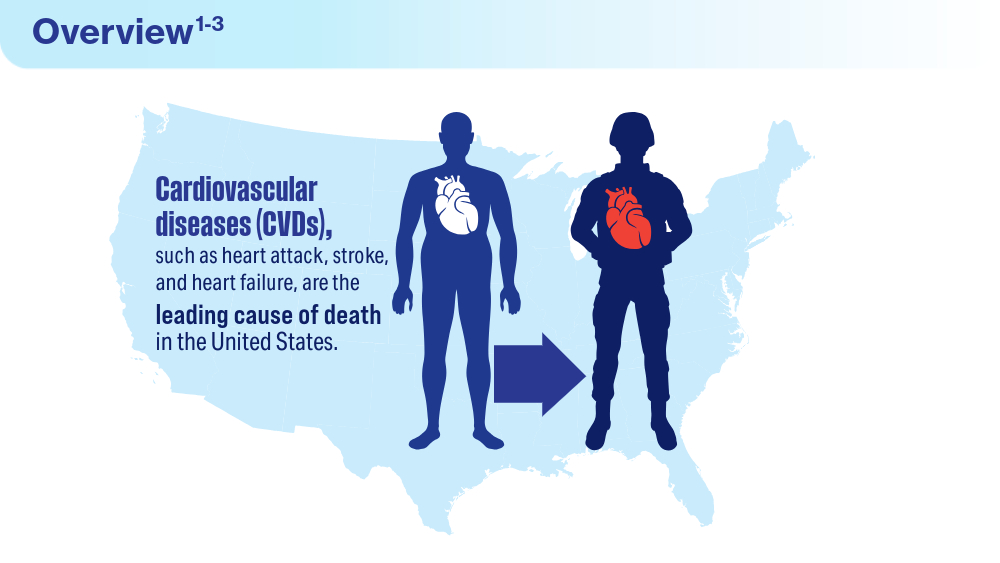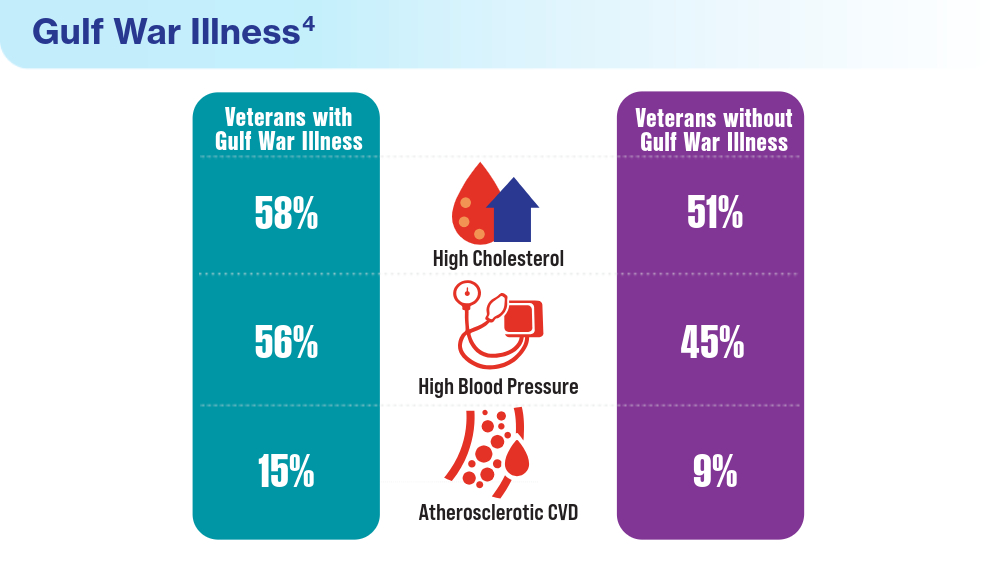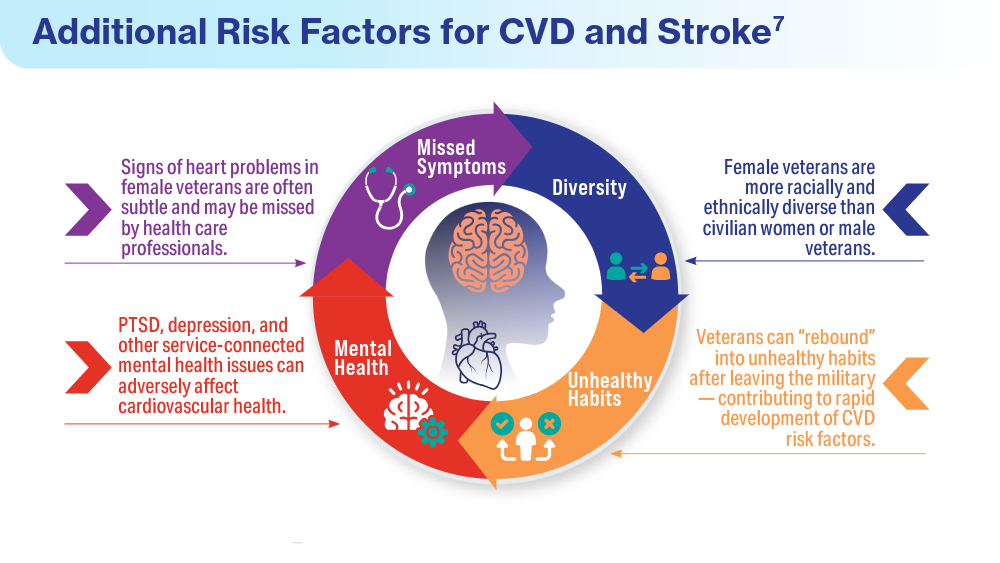SLIDESHOW
Data Trends 2024: Cardiology
August 14, 2024|Federal Practitioner





Author and Disclosure Information
Reviewed by:
Ricardo Correa, MD, EdD
Clinical Professor of Medicine, Endocrinology Institute
Lerner College of Medicine CWRU;
Staff Clinician, Endocrinology Institute
Cleveland Clinic
Cleveland, OH
Dr. Correa has disclosed no relevant financial relationships.





 Only 30% of service members have ideal blood pressure (< 120/< 80 mm Hg) vs 55% of civilians.
Only 30% of service members have ideal blood pressure (< 120/< 80 mm Hg) vs 55% of civilians. Gulf War Illness is a chronic condition, affecting about 1 in 3 of the 700,000 US veterans who served in the early 1990s.
Gulf War Illness is a chronic condition, affecting about 1 in 3 of the 700,000 US veterans who served in the early 1990s. Based on an analysis of annual exams, emergency department visits, and hospitalization records for nearly 130,000 female veterans with PTSD and nearly 260,000 female veterans without PTSD.
Based on an analysis of annual exams, emergency department visits, and hospitalization records for nearly 130,000 female veterans with PTSD and nearly 260,000 female veterans without PTSD.
 Since the onset of the pandemic, researchers have attempted to better understand the long-term effects of COVID-19. Several analyses using a massive database of US veterans’ health records found a dramatically increased risk of dozens of conditions, including heart failure and fatigue, sometimes years postinfection.
Since the onset of the pandemic, researchers have attempted to better understand the long-term effects of COVID-19. Several analyses using a massive database of US veterans’ health records found a dramatically increased risk of dozens of conditions, including heart failure and fatigue, sometimes years postinfection. Veterans hospitalized with COVID-19 between March and December of 2020 were followed for 2 years postinfection to assess their risks for various adverse health outcomes. Although there was a clear decline within the first year, the relative risk for several cardiovascular conditions remained elevated at 720 days.
Veterans hospitalized with COVID-19 between March and December of 2020 were followed for 2 years postinfection to assess their risks for various adverse health outcomes. Although there was a clear decline within the first year, the relative risk for several cardiovascular conditions remained elevated at 720 days. Only 30% of service members have ideal blood pressure (< 120/< 80 mm Hg) vs 55% of civilians.
Only 30% of service members have ideal blood pressure (< 120/< 80 mm Hg) vs 55% of civilians. Gulf War Illness is a chronic condition, affecting about 1 in 3 of the 700,000 US veterans who served in the early 1990s.
Gulf War Illness is a chronic condition, affecting about 1 in 3 of the 700,000 US veterans who served in the early 1990s. Based on an analysis of annual exams, emergency department visits, and hospitalization records for nearly 130,000 female veterans with PTSD and nearly 260,000 female veterans without PTSD.
Based on an analysis of annual exams, emergency department visits, and hospitalization records for nearly 130,000 female veterans with PTSD and nearly 260,000 female veterans without PTSD.
 Since the onset of the pandemic, researchers have attempted to better understand the long-term effects of COVID-19. Several analyses using a massive database of US veterans’ health records found a dramatically increased risk of dozens of conditions, including heart failure and fatigue, sometimes years postinfection.
Since the onset of the pandemic, researchers have attempted to better understand the long-term effects of COVID-19. Several analyses using a massive database of US veterans’ health records found a dramatically increased risk of dozens of conditions, including heart failure and fatigue, sometimes years postinfection. Veterans hospitalized with COVID-19 between March and December of 2020 were followed for 2 years postinfection to assess their risks for various adverse health outcomes. Although there was a clear decline within the first year, the relative risk for several cardiovascular conditions remained elevated at 720 days.
Veterans hospitalized with COVID-19 between March and December of 2020 were followed for 2 years postinfection to assess their risks for various adverse health outcomes. Although there was a clear decline within the first year, the relative risk for several cardiovascular conditions remained elevated at 720 days. Only 30% of service members have ideal blood pressure (< 120/< 80 mm Hg) vs 55% of civilians.
Only 30% of service members have ideal blood pressure (< 120/< 80 mm Hg) vs 55% of civilians. Gulf War Illness is a chronic condition, affecting about 1 in 3 of the 700,000 US veterans who served in the early 1990s.
Gulf War Illness is a chronic condition, affecting about 1 in 3 of the 700,000 US veterans who served in the early 1990s. Based on an analysis of annual exams, emergency department visits, and hospitalization records for nearly 130,000 female veterans with PTSD and nearly 260,000 female veterans without PTSD.
Based on an analysis of annual exams, emergency department visits, and hospitalization records for nearly 130,000 female veterans with PTSD and nearly 260,000 female veterans without PTSD.
 Since the onset of the pandemic, researchers have attempted to better understand the long-term effects of COVID-19. Several analyses using a massive database of US veterans’ health records found a dramatically increased risk of dozens of conditions, including heart failure and fatigue, sometimes years postinfection.
Since the onset of the pandemic, researchers have attempted to better understand the long-term effects of COVID-19. Several analyses using a massive database of US veterans’ health records found a dramatically increased risk of dozens of conditions, including heart failure and fatigue, sometimes years postinfection. Veterans hospitalized with COVID-19 between March and December of 2020 were followed for 2 years postinfection to assess their risks for various adverse health outcomes. Although there was a clear decline within the first year, the relative risk for several cardiovascular conditions remained elevated at 720 days.
Veterans hospitalized with COVID-19 between March and December of 2020 were followed for 2 years postinfection to assess their risks for various adverse health outcomes. Although there was a clear decline within the first year, the relative risk for several cardiovascular conditions remained elevated at 720 days.
Item 1 of 6
